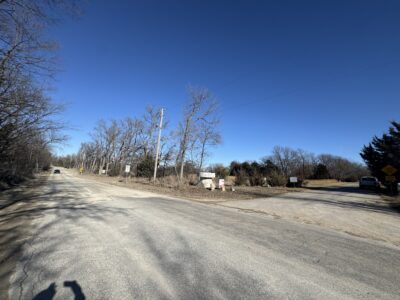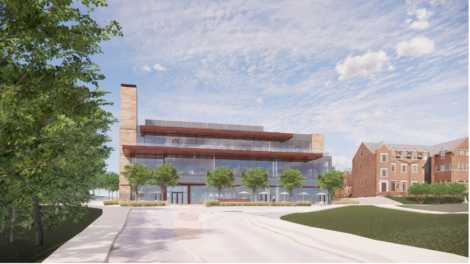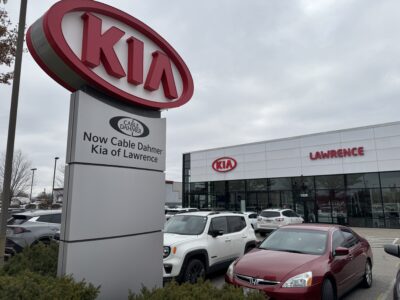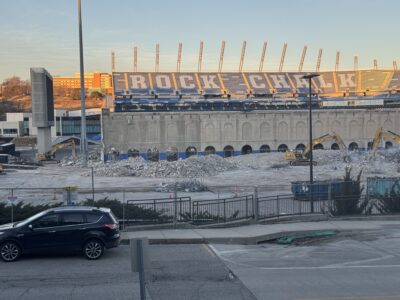
Leader still thinks Panasonic growth will come to Lawrence, but city could work on its image
'I have never been in a city where you can cuss at somebody and not be removed from the meeting'

photo by: John English/Journal-World
The Panasonic battery plant in De Soto is pictured on Sept. 9, 2024.
As the old saying goes, money talks — and when the amount is $4 billion, entire communities will stop what they are doing to listen.
Indeed, the 2022 announcement that Panasonic was going to build a $4 billion, 4,000-job battery plant for electric vehicles in nearby De Soto made Lawrence all ears. How many plant workers would choose to live in Lawrence? How many Panasonic suppliers would locate in the city? Would Kansas Highway 10 need to expand to six lanes just to handle all the people and commerce between Lawrence and De Soto?
Thus far — with Panasonic actively hiring and set to produce batteries in early 2025 — the plant hasn’t been too audible in Lawrence. There’s no single business that Lawrence leaders would point to as a Panasonic prize. As for home construction, well, it definitely is not booming in Lawrence. As the Journal-World recently reported, single-family building permits in 2024 are on pace for a new low in the city.
That doesn’t mean all is quiet in Rob Richardson’s world, though. Richardson is the professional planner whom the Economic Development Corporation of Lawrence and Douglas County hired in 2022 to help the community monitor and take advantage of Panasonic opportunities.
He said those opportunities will come to Lawrence and Douglas County, but they are developing slower than many area leaders had expected. When Panasonic built a similar battery plant in the Reno, Nevada area, there was a boom-like reaction in that community’s economy. But area leaders are now realizing that while the Reno and De Soto plants are similar in what they produce, their paths to opening are quite different.
The Reno plant is located in a much more sparsely populated area, which means the plant has drawn new residents to the area seeking jobs. Leaders of the De Soto plant, however, expect they’ll find their plant’s employees from the existing residents who live within 45 minutes of the plant.
So, what’s the noise Richardson is hearing? Some of the loudest comes from Lawrence City Hall, and it serves as a reminder of another characteristic of money: Not only does it talk, it also can move. So many people want money, that it almost always has an option to land somewhere else.
Richardson thinks some businesses that have considered Lawrence as a landing spot are being dissuaded by some of the vitriol that comes out of a Lawrence City Commission meeting, especially the weekly public comment sessions.
He said any good developer is going to watch a few City Commission meetings before bringing a project to the city, if for no other reason than to anticipate what questions or problems await.
In Lawrence, there are a fair number of weeks where a viewer can see and hear loads of profanity, overtly racist comments and occasional instances of meetings being stopped for police to remove a public commenter.
The majority of speakers at a Lawrence City Commission meeting don’t engage in such activity, but for the handful who do, they are impactful in ways that Lawrence leaders should be concerned about, Richardson said.
“When they (potential developers) go back and look at those meetings and see what it is, they are like ‘well, I don’t need to go be abused like that. I can take my money somewhere else,'” Richardson said. “I’ve heard people say that. Why would I do it here when I can go to Johnson County and not deal with that?”
Are booming public commenters, then, the reason Lawrence hasn’t seen a Panasonic boom? No, no one is saying that. There are other reasons that Panasonic’s impact has been slow to reach Lawrence, and we’ll get into those in a moment. But Richardson, who has been a government professional for years — he was the planning director for Kansas City, Kan., and Wyandotte County when the Legends shopping and entertainment district was being built — is saying that Lawrence has a problem that transcends even a $4 billion project.
It has an image problem with people who can invest money in communities.
“It seems that way,” Richardson said when I asked him whether Lawrence has a more negative vibe toward development and commerce in general than other communities where he’s worked.
“I think the public discourse in Lawrence,” Richardson said, and then paused to choose his words. “First of all, it is not as polite. That is the most polite way I can say that.”
Richardson, who has been a participant in hundreds of meetings in his career as a government employee and consultant, was taken aback by some of what he saw at local city meetings.
“I have never been in a city where you can cuss at somebody and not be removed from the meeting,” Richardson said. “If I had people cuss at an applicant or a commissioner or me, they were removed from the meeting.
“That should be the case everywhere.”
But that is not always the case in Lawrence. City officials have struggled with when to force a public commenter to leave the lectern, trying to balance free speech rights with accepted levels of meeting decorum allowed under the law.
The balance has been off with one key group, Richardson said.
“That hurts our development prospects,” Richardson said of such scenes at City Hall.

photo by: EDC of Lawrence & Douglas County
Rob Richardson
•••
Richardson’s time monitoring development prospects in Lawrence is coming to a close, or at least changing. His two-year contract to serve as the Panasonic Opportunities Manager is expiring next month. Bonnie Lowe, president of The Chamber, which helps manage the EDC, told me there are conversations underway to keep Richardson in some other capacities, especially using his planning background to provide insight into some of the capital improvement and infrastructure challenges facing the community.
As his time in the community starts to wind down, Richardson shared a few thoughts about what he’s learned working in the community, and what the community may want to consider as it works to capitalize on Panasonic in the future. They include:
• Discussions are underway to build an $8 million to $10 million industrial building in Lawrence or Douglas County to have available for companies that want to move to the community. The project is not a done deal. Details including how it would be financed — a combination of public and private financing is a possibility — and where the building would be constructed aren’t yet nailed down.
But Panasonic officials continue to say the De Soto plant is likely to produce another 4,000 jobs outside the plant. Those jobs could be related to everything from shipping companies to battery recycling firms to raw material suppliers to service businesses that help keep the massive plant operating on a 24/7 basis.
Having a building ready and available for those types of companies could be important in landing such firms. That is the approach that is being taken in the De Soto area. The Flint Commerce Center, located about a mile west of the Panasonic plant, already has constructed a 1 million-square-foot industrial building, and has planning approvals for several other large buildings. Panasonic has signed a lease to occupy half of the 1 million-square-foot building, and developers of Flint are marketing the remaining 500,000 square feet to other companies interested in being close to the production center. Richardson said Lawrence is looking at offering a smaller building that would be around 150,000 square feet in size but easily expandable to 300,000 square feet.
Richardson, though, acknowledged that the suppliers for Panasonic are not emerging as quickly as area leaders once had thought. He said Panasonic is ramping up production at the De Soto plant more gradually than it did in Reno. That may be leaving some suppliers feeling they have more time to make decisions about how to serve the De Soto plant. For instance, some suppliers may be deciding in the ramp-up phase that it makes sense for them to simply ship their products from existing plants rather than to build new near the De Soto factory.
However, Richardson said he still thinks the surge of suppliers will come as the De Soto plant gets closer to full capacity.
• Work also is underway to improve development conditions at Lawrence VenturePark, the city-owned industrial park on the eastern edge of Lawrence. Richardson said the site’s past history as a Farmland nitrogen fertilizer plant has caused some red flags to emerge as prospects look at locating in the park.
As the Journal-World reported in 2021, an abandoned landfill was discovered in Lawrence VenturePark during the construction of a new manufacturing facility for U.S. Engineering Metalworks. That unexpected find delayed the project and created new costs. It also created questions about what else may be found in the park.
Richardson said economic development leaders are now working with a former Farmland employee — and using aerial photography — to try to create more certainty about what is beneath the surface at VenturePark. Richardson said he’s optimistic that there are about three lots at VenturePark that enough research can be done on so that the city can tell potential companies that “you aren’t going to find any trash dumps, you aren’t going to find any foundations, you aren’t going to find any chemical stuff.”
Without that research in place, the available land at VenturePark requires certain types of environmental disclosures to be made to companies considering locating in the park.
“The way you have to say it now sets off all the red flags, and when you are in a competitive market and there is a potential delay — even though we are well suited otherwise — they won’t accept any potential delay,” Richardson said. “They’ll go somewhere else.”
• On the housing front, Richardson thinks Panasonic ultimately will create new demand for Lawrence homes. However, it is not likely to be all at once. Rather, Lawrence could be in the running to attract Panasonic employees who have perhaps worked at the plant for a couple of years and decide they want to live closer to the plant.
Richardson said Lawrence should compete well for those residents on quality of life factors. He said Lawrence particularly could be attractive to younger employees who are interested in living in a more urban setting. He noted that Lawrence’s downtown and some of the urban living options it provides are closer to the plant than downtown Kansas City or any such urban living options in Johnson County.
But Richardson said Lawrence needs to focus on building more homes for all types of residents, regardless of what happens with the Panasonic project. He said his planning background suggests a city the size of Lawrence should regularly be building 250 to 300 homes per year to keep the housing market healthy and keep up with demand. Lawrence is on pace to build fewer than 100 single-family homes for the second time in the last three years.
“Lawrence is not growing at a rate that is historically accurate,” Richardson said. “Historically, it has grown its housing market much faster than it has for the last 20 years.”
He thinks that slower growth is putting pressure on the city’s finances, and hopes the community will think broadly in addressing the challenge.
“Lawrence has a very high demand for services and you need more tax money to fund that,” he said. “It looks like things aren’t working very well right now. Is that a residential development problem, an industrial development problem, a commercial development problem, a problem in how we spend our money?
“It is a community and it is a big organism. You have to make sure all of those parts work and are working together. I don’t think the blame game is helpful in that part of it.”







